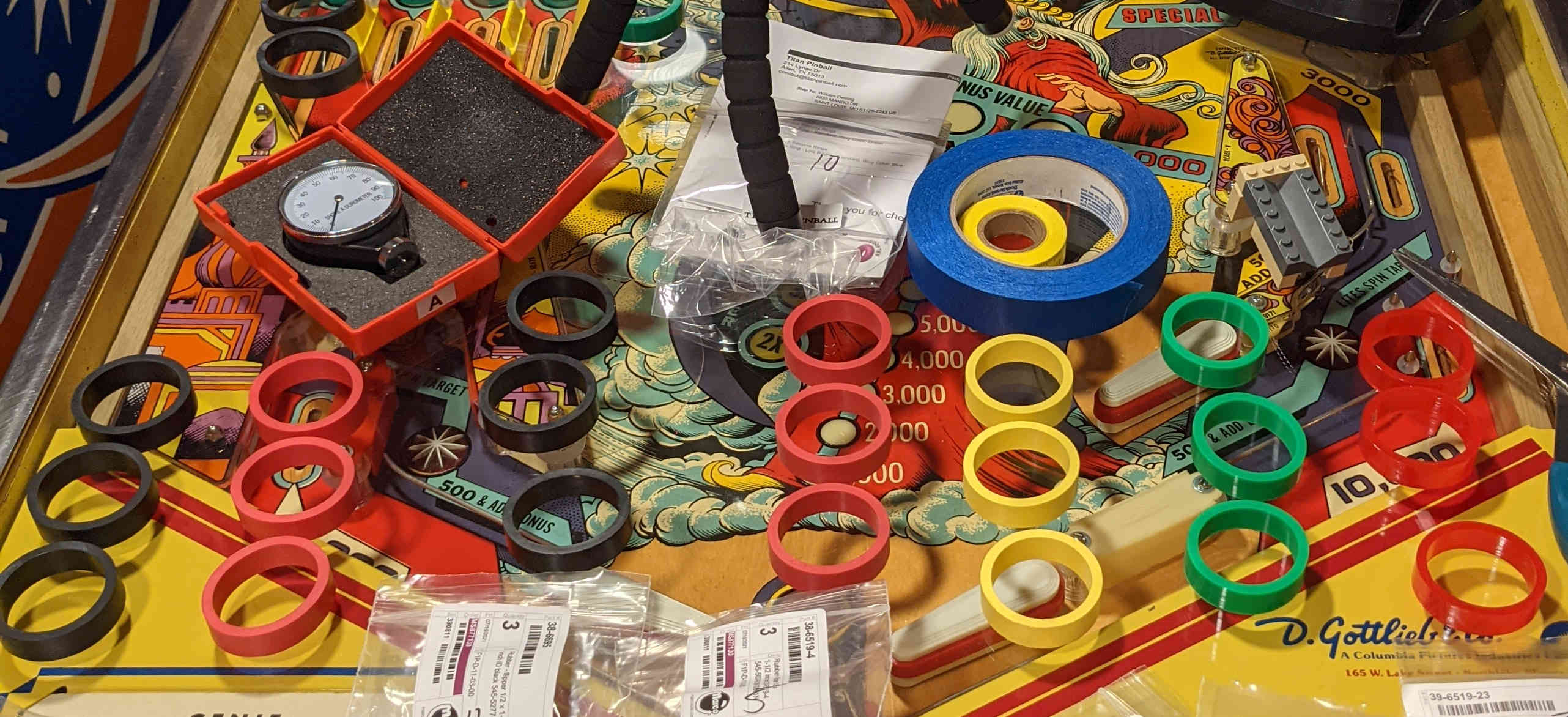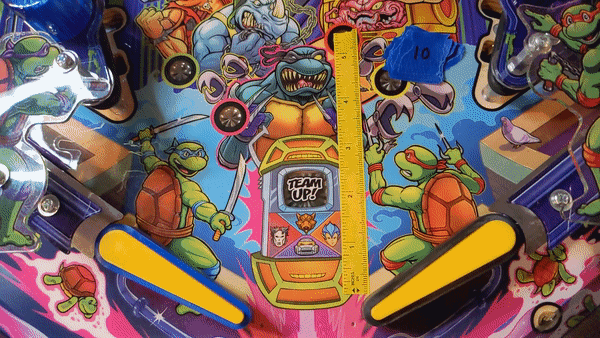By Will Oetting

There are quite a few different types and brands of flipper rubber that can be used for pinball machines. I’ve used several of them and read other’s reviews over my time as a collector, but I thought it might be a good idea to actually do a full comparison of all of the options available. My focus in this comparison is to determine which flipper rubber plays as closely to standard rubber but has the best durability. Since I only buy flipper rings for a small collection of pinball machines, I wasn’t too concerned with price but I have included that information in the comparison.
Flipper Rings
To get a good comparison I wanted to get the standard rubber rings in multiple colors from multiple sources. From the reviews I have read, the colors of the rings also tend to change the way the ball interacts with the rubber and causes differences in game play. Most modern games today come with standard black rubber flipper rings. I just happen to have a fairly recent Stern Teenage Mutant Ninja Turtles that still has the original black rubber rings on it, so I’ve included those in the comparison as well. Those rings also serve as a baseline in several of my tests to allow me to try to match what might be considered as “normal” ball interactions.
When buying the rubber rings for the comparison I also wanted to consider that there might be small differences between rings produced by the same manufacturer and with the same materials. So, I made sure to purchase 3 rings of each in order to try to get a better average of performance.
Flipper Rings Table
Materials
Most of the flipper rings use standard rubber as the material. There are a couple of alternatives to standard rubber that are designed to last longer and not produce as much dust. Flipper dust is a large cause of the playfield getting dirty and grimy which slows down the pinball. Using an alternative to rubber means you don’t have to clean and wax the playfield as much. The most common alternatives are silicone and polyurethane. The main differences between these is of course the chemical makeup; while polyurethane is an organic polymer and contains carbon, silicone is an inorganic substance. Organic compounds are more likely to break down over time if they are exposed to UV light, hence giving flippers made with silicone the most long lasting durability.
Hardness Test
The hardness of the rubber can affect how it interacts with the ball as well as how hard it is to actually get on the flipper bat. To measure the hardness of each flipper rubber I used a Shore Durometer, which is a device specifically made to measure the resistance of indentation on polymers and rubbers. This type of device is commonly used on tires to determine it’s ratings. The higher the Durometer number indicates that it is a harder material.
Hardness Test Table
Refer to the Flipper Rings Table above by the Flipper ID
Bounce Test
I decided that the best way I could compare the flipper rubbers was to measure the amount of bounce a pinball would have if dropped from the exact same point. Even a slight difference in the bounce off a flipper makes a big difference in where the ball goes following the bounce. While videoing this test I noticed that the ball would reach the opposite flipper at different positions and would therefor either go up the other inlane or bounce off the bottom post of the sling shot. The amount of bounce off the rings leads to the amount of random, wild play in the pinball. In general, the more bounce the more the ball is wild.
To do this test I had my son create a Lego ramp that I could tape to the playfield to serve as my launching point. I also used ruler tape to have a set measuring device for each test, and then I videoed each test in slow motion so that I could view how high up on the ruler the pinball reached. I did this test on all 3 rubbers that I purchased for each of the products. The one factor in this test that I don’t think I was able to control for was how taught the flipper ring is on the flipper bat. This definitely could be different between each set but the hope is that the average will help reduce that difference.

Bounce Test Set 1 Table
Refer to the Flipper Rings Table above by the Flipper ID
Bounce Test Set 2 Table
Refer to the Flipper Rings Table above by the Flipper ID
Bounce Test Set 3 Table
Refer to the Flipper Rings Table above by the Flipper ID
Bounce Test Average Table
Refer to the Flipper Rings Table above by the Flipper ID
Grip Test
I also thought that another difference in the rubbers that affects game play is how much grip they have. This often affects the “English”, or sidespin, on the ball as well as how fast it rolls along the flipper. When looking up how to test grip of material I did find some suggestions on dragging weights across the material to see the distance it takes for the weight to stop. I wasn’t able to come up with a good way to do this type of test on the small amount of flipper rubber that I had, so I had to scrap this idea. If anybody has a good suggestion on how to do this test then please let me know.
Conclusions
For full disclosure, TWIP has been working with Titan Pinball for our monthly giveaways for some time now. I also personally tend to buy Titan rings for all of my games because their products have become what I am used to playing on in my home arcade. Part of the reason I wanted to do this comparison was to make sure I had a chance to try out other flipper ring options.
After having to put multiple flipper rings on over and over again, I now really hate those ones that are super hard making them tough to get on the flipper bat. My fingers were definitely hurting after these tests. The hardest rings were the Super-bands with the black standard rubber ones right behind it.
I was quite surprised in the vast difference in bounce across the different sets of rings of the same product. That shows there are a lot of variables that go into how the pinball bounces including the ring. This all contributes to the randomness of play in this great hobby. If you look at the bounce test average table, the biggest differences from the standard set on a Stern machine come into play on the PerfectPlay silicone rings from Pinball Life. Those rings tended to bounce about 0.5cm less high than standard making game play much different. At about 0.3cm difference came the next set of rings: the red and yellow rubber rings from Marco Specialties, Super-bands, and the low bounce Titan rings. I found it interesting that the Titan low bounce rings were marketed as having similar bounce to standard rubber and I guess they do if you compare them to red rubber and not black. The color of rubber in standard rubber rings definitely makes a difference. The closest to the same bounce as the Stern black rings ended up being the red rubber rings from Pinball Life, but with the black rubber from Pinball Life as well as the Titan silicone rings not far behind.
Considering I don’t like the rings that are hard to get on and that I really want to keep my playfield as clean as possible, it looks like the Titan silicone rings are the closest to “standard” game play with all of the benefits of being made of silicone.
Of course, some of this is subjective, so go buy sets of multiple products yourself and try them out to see which are your favorites.
Marco Specialties Flipper Rings
Titan Competitive Silicone Rings
About the Author: Will Oetting
I helped my father-in-law buy his first game, Bounty Hunter, and then instantly missed it when it left the house. That drew me to the community and I was lovestruck pretty hard. I have been working with Jeff behind the scenes of TWIP to help make sure that the website is running at its best. I am also on the TWIPY committee where I help setup the surveys and collect the data for the awards. My current favorite machine is Iron Maiden but I also enjoy games of all types.

You are missing all of the tables…
What browser are you using to view this post? I just checked and I can view the tables but I’m using Chrome.
I am using Chrome as well. Noticed a few other comments around the web noting the same thing. They are showing up now though
As to the grip test, I’d imagine you would need to put a flipper on its side in a brace and find something to drag across it (something small and flat like a flat lead fishing weight) with a string attached to a simple trigger pull gauge to measure the force needed to move it. The actual numbers would be meaningless, but would at least give you something to compare between each of them.
Or you could put the rubber on a flipper, attach something with weight to the top, and see how much force it took to move it/skid. You could both pull using a string or push directly. I don’t think that would effect things, but it might be easier to measure.
Another option would be the same setup and slowly tilt the platform the flipper was resting on. Degrees of tilt until it moves would be the metric.
Great article basis but If I can suggest some adjustment here, I think it will add more to the idea. Also I appreciate any time we apply science and measurement to something so crucial to pinball which is the flipper (and additional rubbers like slings and posts!) so this article has some depth to it.
However, I didn’t leave this article being satisfied with the effort for a few reasons. I hope to share some constructive feedback after complimenting the idea of the article.
I think one thing missing is creating a graph with the bounce metrics across multiple products. Charting the bounce height would have been better served than reading measurements in sentences.
Are there more bounce test videos/GIFs forthcoming? The sample video was great but not sure where the rest of the content is here.
These bounce tests are utilizing the dead bounce flipper skill? did you try any Dead catches?
Can you add measurements of the slope of the playfield for additional data? I know most of it is standard but data points exist in a higher and lower slope video. I suspect the bounce becomes more pronounced at the lower slope!
Can we see the lego ramp and get an understanding of the measurements of it? (height, length, etc?) This allows us to understand the speed of the ball, and it would be really helpful to test at the slowest possible speeds as well as highest.
Was a pain to get the tables visible, had to disable all my security settings. I combined them into one table so it is easier to read and manipulate.
https://docs.google.com/spreadsheets/d/1pGYFT9vRSylxxww6DswPefabQcMlZQ0uu7dr9xOne0Q/edit#gid=0
Great article! Really thorough research and well-presented. For the grip, certainly the measurements are somewhat subjective relative to the skills and opinion of the player. One video test you could perform would be to roll the ball down the inlane and observe the reaction when it crosses the threshhold of the rubber. Does it roll smoothly? Speed up? Slow down? Gain top-spin? Bounce up slightly? Much more difficult to test consistently, but more useful for the player to know, is how does the ball behave in a drop catch? This would obviously be very difficult to test in a consistent fashion, yet I’m sure if you asked a few players how they “feel” you could get a rough idea of which flippers are grippier.
What about Titans and Superbands?
Maybe a follow up with silicon test.
Thanks
Both Titans and Superbands were included in my tests.
Very thorough review, thank you! I love everything Titan!
The trick to getting the difficult ones on is to warm them up in really hot water